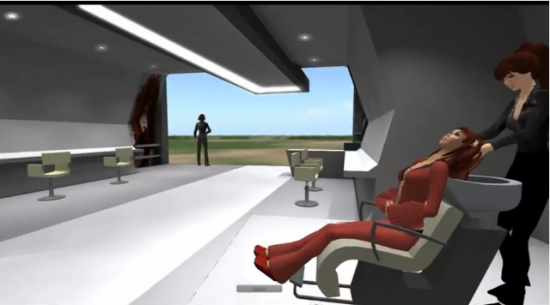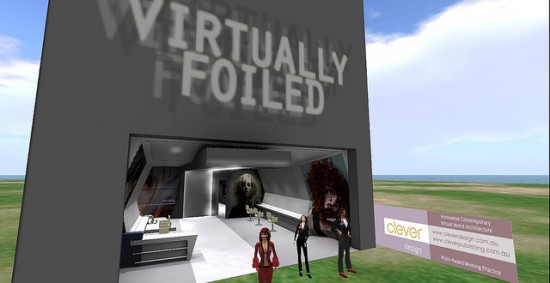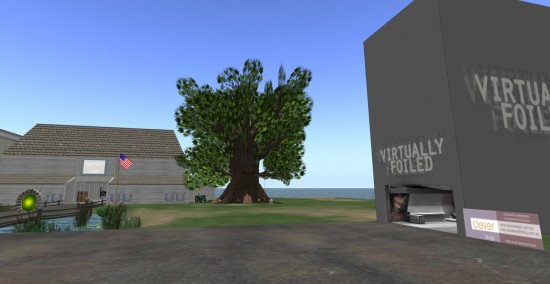Students of Tasmanian Polytechnic had been virtually exposed how to conduct and manage a virtual salon thanks to the school’s Virtually Foiled project.
Virtually Foiled, a virtual hair and beauty salon in OpenSim, provides students and teachers an immersive and realistic experience of what it is like to be working in a beauty salon. The products, the services, the work routines and even the expectations of a contemporary hair and Beauty workplace, are captured by this virtual environment.

The virtual salon was modeled and textured in Lightwave 10.1 with the initial intention of importing the final product into Second Life, project workforce learning leader Vicki Cleaver told Hypergrid Business.
However, access to Second Life on campuses was lost early in the project due to IT network changes, according to Roger Stack, project manager for marketing services. “The project shifted to the use of OpenSim on USB memory sticks,” said Stack. “There was no technical difference between importing assets to Second Life or OpenSim.
The project team also made use of Linda Kellie’s shopping mall OAR files and Kitely‘s Facebook integration. Stack said that Kellie’s shopping mall was used because it provided a wide choice of Creative Commons items for students to customize their avatars and personalize their online spaces during training.
“This was very important because it increased student engagement and their sense of immersion in the virtual world,” he said. “Students’ skills in operating with the virtual world greatly increased as they shopped and decorated while reducing the need for more formalized training.”
With regard to Kitely’s Facebook integration, it was used towards the end of the project because it provided easy access to the virtual world hair salon and shopping mall through Facebook, which was already being used by almost all the students and staff.

“Kitely’s Facebook integration appears to reduce the access barrier to the virtual world,” said Stack.
Through a project partnership with Clever Design, a Tasmanian 3D design company, sophisticated graphic techniques were used to build a realistic and contemporary virtual salon.
“This not only provided a convincing, immersive experience for students, but it has also provided insights into current industry trends in salon services and design,” said Cleaver. Â “Significantly, Clever Design has had recent experience in planning a hairdressing and beauty salon refurbishment, utilizing Second Life-style graphics.”
“This was the first time that a virtual learning environment had been created for the Tasmanian Polytechnic Hair and Beauty team,” she said. “The main issue during the development stage was the technical limitations of the Second Life graphics engine.”
Lightwave 10.1 was used during the initial design of the salon because, according to Cleaver, the native tools within Second Life were not really suited to accuracy and realistic surfacing which was why Virtually Foiled was constructed outside Second Life’s environment.
When asked why they imported it to Second Life, and later on to OpenSim, Cleaver said, “This project was about engaging younger students and creating Virtually Foiled emulated the workings of a real salon environment.” She added that students were creative and had fun learning in this environment.

According to Cleaver, there are advantages conducting classes inside a virtual classroom.
“In a virtual world, it allowed students the opportunity to ‘be someone else’ as an avatar,” she added. “In this sense, the students have become risk takers in their learning and boosted their confidence level.”
Navigating the virtual space and manipulating objects were aspects of learning that are not available in a traditional classroom setting, she added.
“There were twenty year 11 and 12 students, aged 16 to 19, that participated in the pilot program and all of them have creative and social characteristics and prefer hands-on learning,” she said. “Most of the students are Facebook pros although they have limited IT skill sets. They were trained over the period of the pilot which is six months.”
Cleaver said that Virtually Foiled began January of this year and ran for six months. The project ended last month, but Cleaver’s team is very optimistic of making this a sustainable endeavor. “We would like to continue using the salon for experimental learning once the technical issues are resolved. It will be great to communicate with the world in the environment.”
The teachers and students of the pilot program were engaged in a range of professional development activities including creating avatars, navigating the virtual space, manipulating objects, shopping in malls to dress and purchase products and complete the interior design of the salon. Cleaver added that evidence was captured throughout the students’ learning.
“This was an amazing project and one that motivated students to be in the space,” she said.  “The students felt a need to dress and do their hair appropriately before going into the salon to start their learning.  This was an interesting observation by the teachers and understandably so – that they needed to have their personal presentation just right.”
Cleaver also gave advice to people who are doing similar things in Second Life. “Designing in Second Life has its complexities and requires people with high level IT skill sets,” she said. “It would be an advantage if the designer has had experience in Second Life and OpenSim before embarking on a project.
“Given all of the complexities, Second Life is a great learning tool for students,” Cleaver added.
- InWorldz expects downtime this weekend during move - November 13, 2012
- Virtual salon builds confidence - July 23, 2012
- Firestorm viewer upgrades OpenSim support - July 23, 2012
